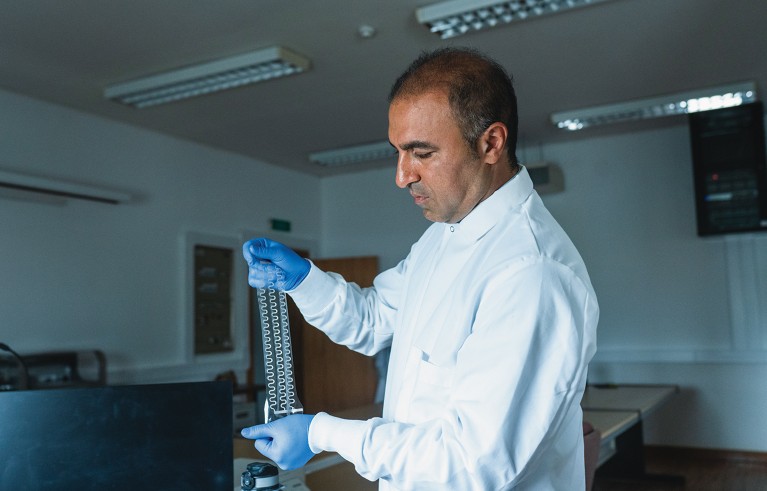Hello Nature readers, would you like to get this Briefing in your inbox free every day? Sign up here.

The metal tiles lining the inside cavity of the Joint European Torus are irradiated with tritium, a radioactive isotope of hydrogen.Credit: CEA-IRFM/EUROfusion/ZUMA Press Wire/Shutterstock
Scientists have started to decommission the United Kingdom’s Joint European Torus (JET) — one of the world’s foremost nuclear-fusion reactors — 40 years after it began operations. The process will take 17 years and will prioritize reusing and recycling parts — and use the knowledge to make sure future fusion power plants are safe and financially viable. JET taught scientists about how to build and fuel ITER, the ambitious US$22-billion fusion reactor in France, which scientists aim to have up and running in the 2030s.
Nature | 5 min read
More than 2,000 metres below the Jinping Mountains in southwest China, the world’s deepest and largest underground laboratory has just opened. Experiments that fill the 330,000-cubic-metre space will help to hunt down dark matter — the hypothetical substance that is thought to make up more than 80% of the mass in the Universe. The mountain will shield sensitive detectors from noise that could interfere with the signal from potential dark matter particles, which are almost impossible to detect. It’s “like trying to hear the tiny voice of a child inside a stadium where everybody’s shouting”, says physicist Marco Selvi.
Nature | 5 min read
A reconstruction of the ancient extinct shark Otodus megalodon as long and slender has reignited the debate over what the giant predator really looked like. Sharks’ cartilage skeleton doesn’t fossilize well and no complete megalodon fossil has ever been found. A 2022 study on megalodon vertebrae concluded that it was short and stocky, like a great white shark (Carcharodon carcharias), but much larger. Researchers who have now reanalysed the same vertebrae suggest that megalodon’s length was underestimated.
Smithsonian Magazine | 5 min read
Reference: Palaeontologia Electronica paper
Features & opinion
Table of Contents
Scientists are closing in on therapies to treat conditions in which people’s immune systems attack their own bodies, such as type 1 diabetes, lupus and multiple sclerosis. Instead of suppressing the entire immune response, researchers try to selectively wipe out disease-causing cells or deprogram them by administering the very antigens that they attack. In one study, engineered immune cells put 15 people’s autoimmune conditions into remission. “The results are mind blowing, boggling, outstanding,” says neuroimmunologist Lawrence Steinman. But he cautions against undue optimism. “Every time these are taken to the clinic, including some of my own efforts, they fall short of getting a drug approval.”
Nature | 11 min read
Building regulations that focus on energy efficiency can help people to survive extreme heat or cold, even without power, argues Earth scientist Meredydd Evans. Insulation and built-in window shades can help to maintain liveable conditions for longer. The cost is worth it, says Evans. “Constructing buildings to code is much less expensive than retrofitting them later or paying for the effects of extreme heat on human lives and health.”
Nature | 5 min read
Videoconference fatigue is real. We aren’t able to clearly read each other’s body language or make the usual amount of eye contact during online meetings, explains neural engineering researcher Gernot Müller-Putz. Here are his tips to reduce Zoom exhaustion:
• Take a short break every 30—45 minutes
• Turn off your camera after greeting others to focus on the conversation and avoid feeling self-conscious
• Keep meetings short by encouraging everyone to do them standing up.
NPR podcast | 11 min listen
Reference: Scientific Reports paper
Where I work

Mahmoud Tavakoli is director of the Soft and Printed Microelectronics Laboratory in Coimbra, Portugal.Credit: Ana Paganini for Nature
Engineer Mahmoud Tavakoli leads a multidisciplinary team that develops wearable electronic devices that are less invasive than standard equipment — like the stretchable circuit pictured here. “The e-patches we make that use the same technology and can monitor heart rate, respiration rate, brain activity, body temperature and blood oxygen levels,” says Tavakoli. “We aim to give patients in hospital more autonomy and help them to go home sooner.” (Nature | 3 min read)
Today, I’m delving into chemist and science writer Ash Jogalekar’s list of academic papers that “transcend disciplines and stand as timeless testaments to both great thinking and great writing”. Theoretical physicist Philip Anderson’s 1972 paper ‘More is different’ for example is very useful to explain why chemistry can’t be reduced to physics, Jogalekar says.
Please send your favourite scientific bedtime reading — alongside any feedback on this newsletter — to briefing@nature.com.
Thanks for reading,
Katrina Krämer, associate editor, Nature Briefing
With contributions by Flora Graham, Gemma Conroy and Sarah Tomlin
Want more? Sign up to our other free Nature Briefing newsletters:
• Nature Briefing: Anthropocene — climate change, biodiversity, sustainability and geoengineering
• Nature Briefing: AI & Robotics — 100% written by humans, of course
• Nature Briefing: Cancer — a weekly newsletter written with cancer researchers in mind
• Nature Briefing: Translational Research covers biotechnology, drug discovery and pharma
